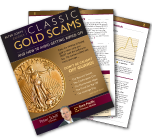While not nearly as common as overpriced numismatics, every now and then the precious metals investor will come across the opportunity to purchase natural gold nuggets. While they may be appealing at first glance, these opportunities are just another distraction from the real purpose of investing in precious metals: as a long-term, liquid store of wealth.
Often these natural nuggets are called “placer gold,” which are basically deposits of gold that have found their way to the Earth’s surface, either in the silt of a riverbed or the topsoil nearby. When you think of the classic image of a ’49er panning for gold, this is the metal he is looking for. The gold can range in size from the tiny flakes you might find floating in bottles in souvenir shops to substantial nuggets weighing several grams or more.
There are legitimate placer mining companies who still operate today around the world, though the profit margin is highly variable. Placer gold can be anywhere from 50-85% pure, with the remainder being a hodgepodge of other metals. To make money, these operations search not just for gold, but also precious gems and valuable minerals.
Clearly it takes more resources to further refine placer gold into a pure product. So when you see gold nugget sales at well over the spot price, red flags should go up. How can gold nuggets be that costly when they aren’t even pure?
The seller may make the point that placer gold finds its value as a collector’s item. They may emphasize the unique quality of the gold nugget as a natural phenomenon, like a gemstone, unprocessed by humans. They may assure you this unique beauty is appealing to jewelry makers who search out nuggets for use in custom craftwork. Keep in mind that these sellers are often just hobbyist collectors or amateur gold panners, and so there’s a chance they haven’t even verified the percentage of gold in their specimen. Profitable placer mining operations are refining their metals themselves or else selling their product to refineries, and aren’t going to waste their time trying to sell unrefined gold on the Internet one nugget at a time.
Gold has fascinated humanity since the beginning of time, and natural gold nuggets do hold a certain aesthetic appeal to the Midas in all of us. This is what nugget salesmen are betting on. Unless you have a lot of extra cash to throw around, and are looking for a collector’s item as a gimmick to share with your children and friends, you’d be wise to pass on these offers.
You can acquire a pure troy ounce gold coin or bar for significantly less than the same weight in impure gold nuggets. Not to mention, of course, the problem of an exit strategy. If the day comes when you need to sell your gold back to the market for whatever reason, a well-known coin from a reputable mint is going to be infinitely easier to sell than a handful of natural nuggets. All of the sudden, you may find yourself as the seller on eBay trying to convince buyers of the unique value of your overpriced “investment.”

